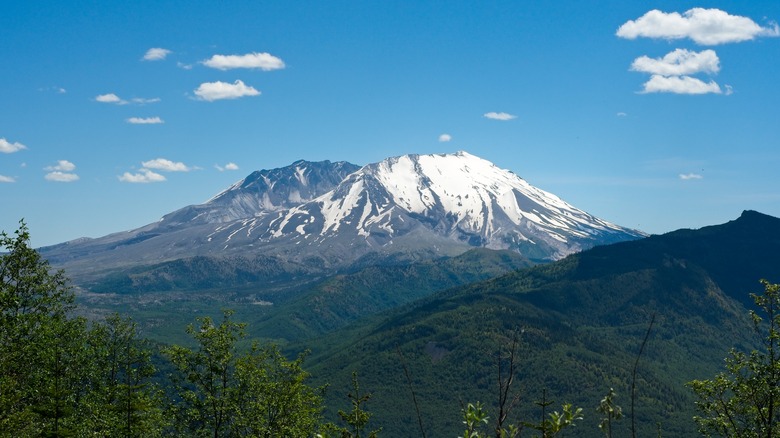Washington State Has The Deadliest And Most Destructive Volcanic Eruption In US History
Around the world, volcanic eruptions are daily geological events, but most of this activity lands low on the Volcanic Explosivity Index, a scale that measures the intensity and magnitude of eruptions. However, high level volcanic explosions do happen, as was the case with Mount Saint Helens in Washington state, which became the most deadly and destructive eruption in American history.
The Mount St. Helens eruption in 1980 started on March 27 and didn't stop until October 28 (give or take a few days), but it was the explosive eruption on May 18 that had a VEI of 5. That day began with the bulge on the volcano's north flank sliding away within seconds of a magnitude 5.1 earthquake. This created a 23-square-mile landslide, the largest in recorded history, that depressurized the magma system and triggered strong explosions of steam, ash, rocks, and volcanic gas over a 230-square-mile area. Meanwhile, about 520 million tons of ash spewed 15 miles into the air, and prevailing winds dispersed it east, causing total darkness up to 250 miles away and circling the Earth in 15 days. On top of that, pyroclastic flows — an extremely hot and deadly current of volcanic ash, rock, and gas — flowed out at 50 to 80 mph and went as far north as 5 miles. A number of lahars — a volcanic mudflow mixture that acts like cement — poured through the river valleys, too.
As a result of the volcano eruption and all of this activity, 15 miles of railway and over 185 miles of road were destroyed, alongside 27 bridges, more than 200 homes, and over 4 billion board feet of timber. Plus, 57 people lost their lives, mostly from ash-related asphyxiation.
Could a repeat of the explosive Mount Saint Helens eruption happen again?
Mount St. Helens, a composite volcano, (one of the three types of volcanoes) is part of the Ring of Fire — an area which almost fully encompasses the Pacific Rim and provides 75% of the activity caused by the world's 1,500 active volcanoes. In fact, about 10% of the active volcanoes on Earth (161 to be exact) are located within the United States, more than any other country. While the 1980 eruption of Mount St. Helens was the most deadly and destructive in U.S. history, most of its subsequent eruptions haven't been as explosive.
No activity at Mount St. Helens since 1980 has reached a VEI of 5, but there was some recorded activity with a VEI of 3 during an eruptive period lasting from 1990 to 1991. Also, the U.S. Geological Survey's Cascades Volcano Observatory lists the volcano as having very high threat potential to people and property, and volcanologists expect it to have another explosive event during our lifetimes. They are closely monitoring the area for similar types and frequency of activity to detect a potentially destructive situation before it happens.
The good news is that researchers have already been successful with predicting smaller eruptions up to three weeks ahead of time. The problem is that they can't predict the size, duration, or the exact activity that will occur, such as lava flows. However, now that there's a deep crater from the 1980 eruption, the massive landslide and lateral blast that previously occurred are unlikely to happen again.

